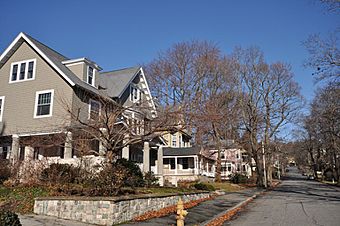Hammond Heights facts for kids
Quick facts for kids |
|
|
Hammond Heights
|
|

View of Germain Street
|
|
| Location | Properties along Germain, Haviland, Highland, and Westland Sts. and Institute Rd., Worcester, Massachusetts |
|---|---|
| Built | 1851 |
| Architect | Multiple |
| Architectural style | Colonial Revival, Italianate, Queen Anne |
| MPS | Worcester MRA |
| NRHP reference No. | 80000531 |
| Added to NRHP | March 05, 1980 |
Hammond Heights is a special old neighborhood in Worcester, Massachusetts. It's on the west side of the city. This area is famous for its beautiful houses. Most of these homes were built between 1890 and 1918. The neighborhood is a great example of how homes were built around the year 1900. It shows many different building styles from that time. Hammond Heights was added to the National Register of Historic Places in 1980. This means it's an important historical place.
History of Hammond Heights
Before 1890, the land where Hammond Heights now stands was a farm. It belonged to a man named John Hammond. His old house, built in the 1850s, is still there on Highland Street. It's built in a style called Italianate. This style often features low-pitched roofs and tall, narrow windows.
Developing the Neighborhood
People started planning to divide the farm into building lots as early as 1886. The whole area was built up between 1890 and 1928. Most of the houses are made of wood. Many of them were designed by architects just for their first owners. This means each house was often unique.
Architectural Styles You Can See
The houses in Hammond Heights show off several cool architectural styles.
- Queen Anne: These homes often have towers, fancy porches, and different textures on their walls. They look very detailed and grand.
- Colonial Revival: This style brings back ideas from early American colonial homes. They often have classic, balanced designs with columns or grand entrances.
- Craftsman: These houses focus on natural materials like wood and stone. They often have simple, sturdy designs and a handmade feel.
- English Revival (Tudor): These homes look like old English cottages. They often have steep roofs, tall chimneys, and decorative half-timbering (wood beams on the outside walls).
The first streets to be built were Germain and Highland Streets. On Germain Street, you can find two excellent examples of Queen Anne architecture. One of these was even shown in a catalog by famous architects Barker & Nourse. You can see good examples of Colonial Revival homes at 26 Haviland Street and 11 Westland Street. Also, 28 Haviland Street is a very unique house. It mixes Arts and Crafts style, which values handmade quality, with touches of the Prairie School. Prairie School homes often have long, low lines that blend with the landscape.



